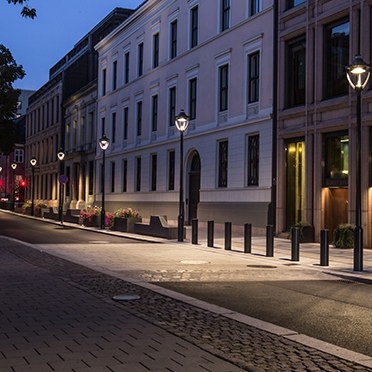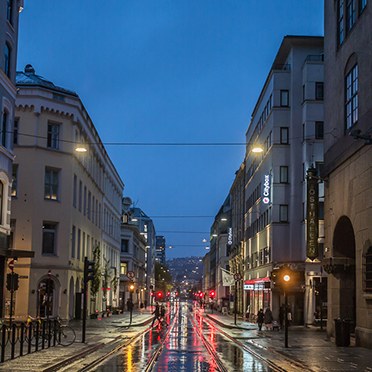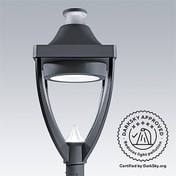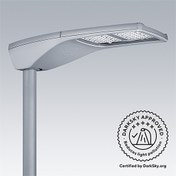City of Oslo, Norway
Products
- Lamp efficacy
Lamp efficacy
Ensuring the lamp efficiently converts electricity into light (lm/W).
- Ballast classification
Ballast classification
Controlling the electricity supply to the lamp (Energy Efficiency Index).
- Luminaire distribution
Luminaire distribution
Controlling light emission using optics which bend and shape the light to the correct location.
- System efficacy
System efficacy
Combining optical and thermal control within the luminaire (luminaire lm/W).
- Presence/absence detection
Presence/absence detection
Providing lighting only when it’s needed.
- Daylight detection
Daylight detection
Reducing waste light during daylight hours.
- Constant illuminance
Constant illuminance
Producing the correct lighting levels for the duration of the maintenance period.
- Task-scene setting
Task-scene setting
Allowing the user to set scenes and adapt the lighting to different tasks.
- Timed off
Timed off
Automatic cut-off to turn all lights off during unoccupied hours.
- Task lighting
Task lighting
Lighting task areas with the correct amount of light.
- Zoning of lighting
Zoning of lighting
Zoning lighting in accordance to occupancy patterns or window location.
- Maintenance schedule
Maintenance schedule
Tailoring maintenance schedules in accordance to product age, performance and environment.
- Waste light
Waste light
Eliminating waste light which does not hit the intended target.
- Reflectance
Reflectance
Taking advantage of light which is reflected from the surface within the space.
- Visible smart metering
Visible smart metering
Enabling results of actions to be quickly seen as increased or decreased energy use to encourage responsible energy consumption.
Background
As the capital city of Norway, Oslo is the hub of Norwegian trade, government, banking, industry and shipping. Oslo has been ranked number one in terms of quality of life and is among the 39 signatory cities to the LUCI Charter on Urban Lighting. The LUCI Charter aims to promote a culture of sustainability by considering factors including maintenance, recycling, light pollution, energy efficiency and quality of life.
The City of Oslo is a long-term Thorn customer and in 2014 Thorn won a public tender to replace its mainly 80/125/250W mercury fittings and closed protocol city controls for street lighting.
Lighting objectives
The City of Oslo wanted a smart lighting solution using luminaires, control devices and a city lighting management system that would work with recognised and open protocols.
The key objectives for the project were to firstly improve road and public area safety, secondly to achieve energy savings using new technology and controls and thirdly, to limit obtrusive lighting while maintaining a classic decorative design for some fittings.
Rather than going for a 5 lux or less average requirement in residential areas, Oslo wanted MEW4 class lighting according to EN 13201, which also covers uniformity on wet roads and threshold increment glare evaluation.
Lighting solution
A total of more than 4,000 Thorn Legend, Thor, Urba and R2L2 street lanterns have been installed across the city.
For the city centre’s pedestrianised and mixed traffic areas, Thorn’s modern heritage post-top/suspended LED Legend lantern is providing high performance decorative lighting.
For other central street areas, including in between buildings, Thor is being used with suspended/catenary installation. Thor is a smart LED lantern offering easy integration of connectivity and sensors into city environments. Using traffic management data, Thor automatically adapts lux levels according to density and standards. Combined with Thorn’s high performance R-PEC optic, it provides quality lighting which balances both performance and comfort.
Finally, R2L2 is installed across residential and less populated areas outside the city centre. R2L2 is a complete road lantern family at the forefront of LED technology to offer excellent lighting performance. Also fitted with the R-PEC optic, R2L2 offers 12 types of light distribution for precise light placement with no waste light.
For effective lighting control and maximum comfort and energy savings, all lanterns benefit from SL21 Lon Works nodes from Citylone.
Results and benefits
High quality lighting appropriate for use and conditions helps to promote improved safety with better visibility across the city.
By adopting MEW4 class lighting according to EN 13201 there always is enough light to improve safety while full dimming controls ensure there is no over-lighting either. Light levels are based on the time of day and knowledge of traffic density or activity in each part of the city, across 750 connected areas.
Importantly, energy efficient LEDs help to improve efficiency between 30 and 80%, depending on dimming levels. This creates a win-win situation with better lighting levels than before and reduced energy consumption.
Additional controls are also planned for events or busier times such as on a Friday or Saturday evening.
Comfort for users and residents is another key benefit. With no uplight, Legend in particular effectively controls obtrusive light to create a comfortable environment. To soften the light impression Thor additionally has a very large luminous area.
Facts
- Light levels based on the time of day and knowledge of traffic density or activity in each part of the city, across 750 connected areas
- Energy consumption reduced by 30-80%, depending on dimming levels
- MEW4 class lighting according to EN 13201, which also covers uniformity on wet roads and threshold increment glare evaluation









